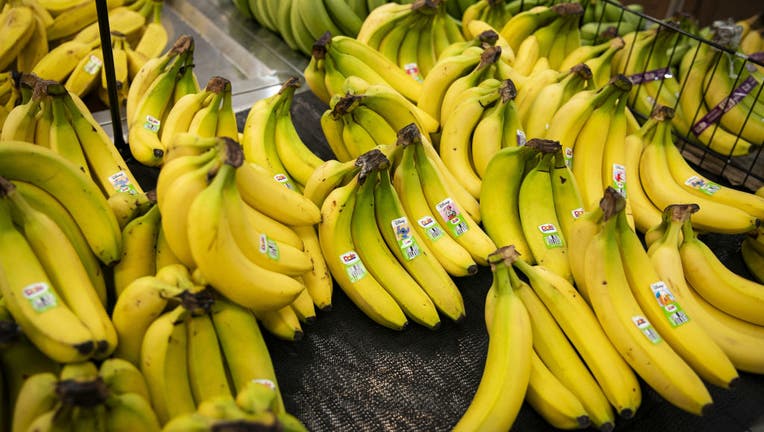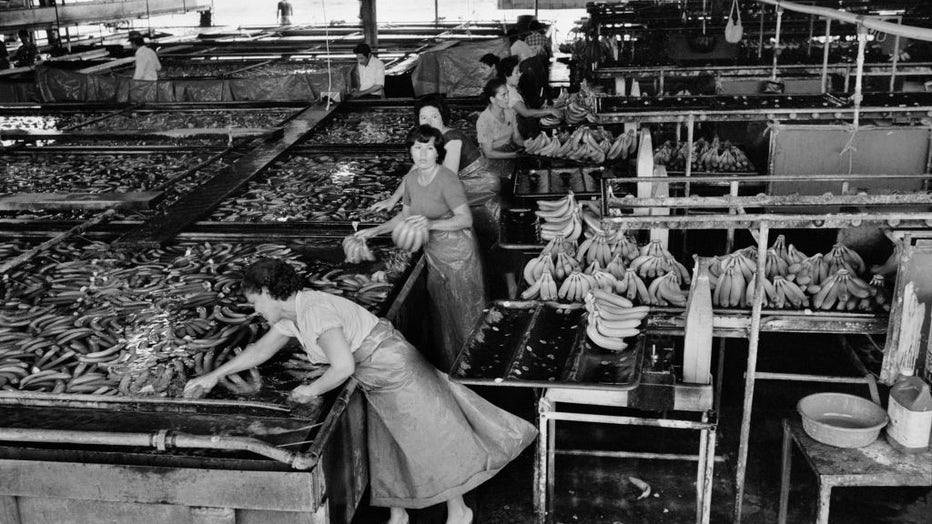Will bananas go extinct? Fungal disease threatens popular variety, scientists warn

FILE - Dole bananas at a H Mart grocery store in Fairfax, Virginia, US, on Thursday, April 6, 2023. Photographer: Al Drago/Bloomberg via Getty Images
Bananas are among the most grown and eaten fruits worldwide. There are more than 1,000 varieties of bananas, but the most common is the Cavendish banana – which accounts for just under half of all global production.
But a serious threat to the Cavendish banana has scientists sounding the alarm about their future.
A fungal disease, called Panama disease Tropical Race 4 (TR4), was first detected in 1990 in Taiwan and has spread to more than 20 banana-producing countries – including those in Central and South America, according to the Food and Agriculture Organization of the United Nations.
Once farmland has been hit with TR4, managing the disease becomes challenging, costly, and can cause complete yield loss. The soil-borne pathogen spreads through infected plants, contaminated soil and water. But to move long distances, it needs the assistance of humans.
"We are really good at moving diseases around the world," explained Professor James Dale, who leads the Banana Biotechnology Program at the Queensland University of Technology in Brisbane, Australia.
"(TR4) spreads slowly and silently. Once it is noticed, it has already been there for a number of years," Dale told FOX Television Stations.
What’s happening to Cavendish bananas happened before
Cavendish bananas dominated the global market in part because they were resistant to a disease that killed its predecessor – the Gros Michele variety.
"Gros Michel was the previous ‘world export banana.’ However, in the late 1800s and early 1900s, this variety began to die from Panama Disease but (tropical) race 1, not TR4," explained Dale, who is among a team of 20 scientists and technicians who have been working on the genetic improvement of bananas for more than three decades.
The disease that killed Gros Michel is caused by a fungus called Fusarium oxysporum fsp cubense, which lives in the soil and becomes virtually impossible to eradicate.
"It probably originated in Southeast Asia, as did TR4," Dale said, adding that it infects the banana roots and kills the tissue as it spreads through the plant.
The export banana industry – including the massive United Fruit Company (now Chiquita) – changed to Cavendish in the 1950s because it was resistant to the tropical race 1. But it also had other characteristics that made it the ideal export banana, according to Dale.
"It is high yielding, it has a thick skin and so travels very well and it has very good taste and texture," he explained.

FILE - Elevated view of workers at an unspecified fruit company as they sort Cavendish bananas from a fresh-water holding tank and move them to a conveyor belt, northeast Honduras, October 1982. (Photo by Robert Nickelsberg/Getty Images)
Why are Cavendish bananas so vulnerable to disease?
Cavendish, like most other banana varieties, was never bred. It was a selection of a naturally-occurring hybrid "and is probably more than 1000 years old, a true heritage variety," Dale said.
"It is vegetatively propagated as it doesn’t have seed. It is grown from suckers or tissue cultured plantlets. There are many other crops that are vegetatively propagated, usually from cuttings and grafting," Dale explained.
This includes foods like oranges and other citrus, apples, grapes, peaches, potatoes, and sweet potatoes.
"All these crops are threatened by diseases because they are not constantly being conventionally bred for disease resistance," Dale continued. "Cavendish is particularly vulnerable because it is grown in vast monocultures."
Scientists working to save Cavendish bananas
Dale doesn’t believe the Cavendish banana will suffer the same fate as the Gros Michel banana, thanks to the work of scientists developing genetically-modified (GM) versions.
His team has created a genetically modified variety of Cavendish banana, called QCAV-4 bananas. These bananas have been grown in field trials in Australia for over six years and have shown to be "highly resistant" to TR4.
The QCAV-4 banana was previously submitted in the spring for regulatory approval in Australia, a process which takes at least a year.
"We and others are developing gene-edited versions (of Cavendish bananas), which should come up with a similar line but without the scary ‘GM’ tag.’ Essentially a work around to placate the public," Dale said. "And there are conventional breeding programs attempting to recreate a Cavendish that is resistant."
Another team at the University of Cambridge has been studying a new grafting technique – or a new way to combine two species of grass-like plant, including bananas, using embryonic tissue from their seeds.
The technique allows beneficial characteristics, such as disease resistance or stress tolerance, to be added to the plants, according to the university.
RELATED: Scientists calculate Earth will likely cross crucial warming threshold in early 2029
This story was reported from Cincinnati.

